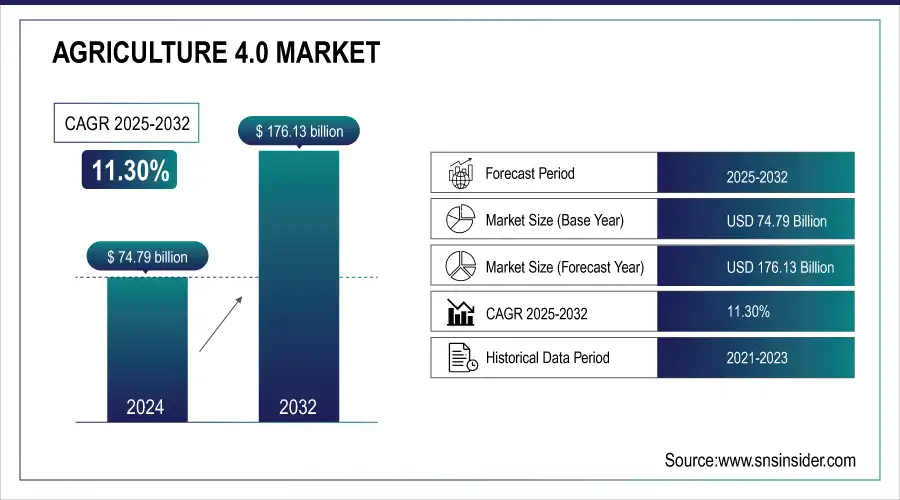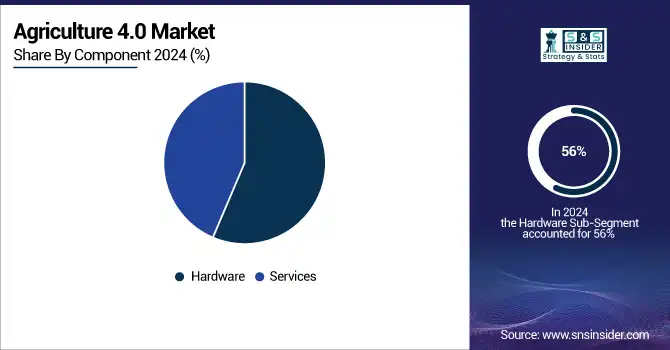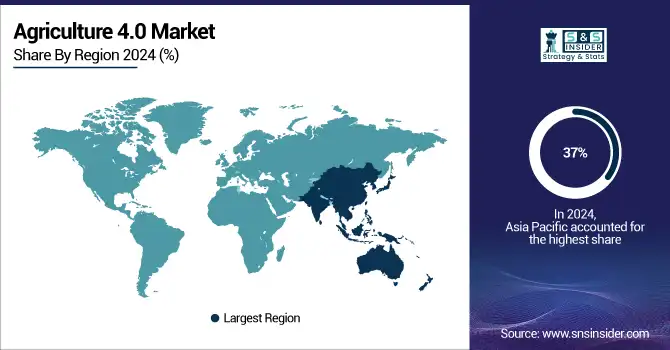Agriculture 4.0 Market Report Scope and Overview:
The Agriculture 4.0 Market Size was valued at USD 74.79 billion in 2024 and is expected to reach USD 176.13 billion by 2032, growing at a CAGR of 11.30% from 2025-2032.

Get more information on Agriculture 4.0 Market - Request Sample Report
This report includes an in-depth analysis of key factors driving market growth, such as the adoption rate of advanced technologies, investment and funding trends in agricultural innovations, and the environmental impact metrics of modern farming practices.

Agriculture 4.0 Market Size and Forecast:
-
Market Size in 2024: USD 74.79 Billion
-
Market Size by 2032: USD 176.13 Billion
-
CAGR (2025–2032): 11.30%
-
Base Year: 2024
-
Forecast Period: 2025–2032
-
Historical Data: 2021–2023
Agriculture 4.0 Market Highlights:
-
IoT, AI, robotics, and automation are transforming agriculture, enabling precision farming, real-time data collection, and predictive insights
-
Mechanized equipment and AI systems reduce labor, minimize errors, and enhance sustainability and profitability
-
High adoption costs and limited skilled labor slow the uptake of advanced technologies
-
Data security, connectivity gaps, and infrastructure integration challenges restrict widespread adoption
-
Growing use of Big Data, government support, and partnerships between agri-tech firms drive market opportunities
-
Sustainable farming methods and livestock monitoring solutions create new avenues for productivity and environmental impact improvements
Additionally, the report covers evolving consumer trends, including demand for sustainable and efficient farming solutions, and the transformation of supply chains through digitalization and automation. Agriculture 4.0 is poised to revolutionize the sector, driving sustainable practices while enhancing productivity across the global agricultural landscape.
Agriculture 4.0 Market Drivers:
-
Technological Advancements in IoT, AI, Robotics, and Automation Transforming Agriculture 4.0 for Precision, Efficiency, and Sustainability
The widespread adoption of IoT, AI, robotics, and automation in agriculture is revolutionizing farm operations. These new technologies allow precision agriculture, with real-time data collection and analysis to optimize crop output and resource efficiency. Mechanized equipment and robots automate work such as sowing, reaping, and pest management, lessening the reliance on human labor and cutting down on errors. Furthermore, AI-based systems provide predictive insights that forecast crop health problems and climatic fluctuations, leading to improved decision-making. Consequently, these technologies are improving efficiency, sustainability, and profitability, propelling the farming industry towards a smarter, more integrated future, while mitigating issues such as climate change and labor shortages. This change is propelling the development and growth of Agriculture 4.0.
Agriculture 4.0 Market Restraints:
-
Barriers to Agriculture 4.0 Adoption High Costs Skilled Labor Shortage Data Security Integration Issues and Connectivity Gaps
The high upfront cost of adopting sophisticated technologies such as AI, robotics, and IoT systems is a major barrier, especially for small farmers and agribusinesses. Most are unable to pay the initial fees of technology adoption, which hinders them from competing in a technology-based market. Furthermore, an insufficient number of skilled laborers who can manage and maintain these advanced systems makes widespread adoption even more challenging. Data security and privacy issues also become threats, as agricultural operations increasingly rely on cloud-based systems and data exchange. Integration issues with current infrastructure and regulatory risks in certain areas hold back market advancement. In addition, unequal availability of technology across rural areas, especially poor internet connectivity, slows down the acceptance of Agriculture 4.0 solutions.
Agriculture 4.0 Market Opportunities:
-
Growth prospects for Agriculture 4.0 driven by big data, sustainability, innovation, government support, and advancements in AI, IoT, and robotics.
The growing use of Big Data and analytics is transforming decision-making in agriculture so that farmers can maximize the allocation of resources, forecast yields, and maximize overall productivity. Further, the demand for sustainable farming methods is boosting the requirement for technology that minimizes waste and environmental footprints. In developing economies, government incentives and increased awareness of smart farm methods hold considerable growth potential, and increasing technological innovation in AI, IoT, and robotics provides scope for ongoing innovation. Intersectoral collaboration between agricultural players and technology firms will additionally spur adoption. Additionally, the advent of livestock monitoring is creating new opportunities for enhancing animal welfare, health, and productivity, fueling market growth. These factors collectively offer significant growth prospects for Agriculture 4.0.
Agriculture 4.0 Market Segment Analysis:
By Component
The hardware segment led the Agriculture 4.0 market with the largest revenue share of approximately 56% in 2024. This is fueled by the extensive use of sophisticated agricultural machinery, sensors, drones, and automated systems that are the core of Precision farming. These technologies allow farmers to enhance operational efficiency, lower costs, and enhance yields. The growing need for automation, IoT integration, and real-time data collection further reinforces the hardware segment's dominant position in the market.
The services segment is expected to expand at the fastest CAGR of around 13.37% between 2025-2032. This is because the increasing demand for data analytics, cloud services, and consulting that facilitate the adoption and optimization of cutting-edge agricultural technology is driving growth. With more farmers turning to data-driven insights for decision-making, the demand for services such as system integration, maintenance, and technical support is increasing quickly, helping the segment grow at a faster rate.

By Application
The farming segment led the Agriculture 4.0 market with the largest revenue share of approximately 25% in 2023. This is fueled by the growing use of sophisticated technologies like AI, IoT, and robotics for Smart agriculture. These technologies enable farmers to maximize the use of resources, improve productivity, and enhance crop yields, thereby boosting their operational efficiency. Increasing application of sustainable farm practices, complemented by requirement for data-led decision-making further supports the sector's market supremacy.
The Smart Greenhouse segment is expected to expand with the fastest CAGR of roughly 13.77% over the period from 2024-2032. This will be mainly triggered by increasing necessity for controlled environment agriculture that sustains maximum agricultural production with lower resource utilization. Smart greenhouses with automation, sensors, and data analytics enable real-time monitoring of conditions such as temperature, humidity, and soil conditions, enhancing crop health and yield. The growth of this segment is also driven by the growing emphasis on sustainable agriculture practices.
By End-use
The agro-forestry segment was the leader in the Agriculture 4.0 market with the largest revenue share of approximately 40% in 2024. This is mainly attributed to the increasing focus on sustainable land management and incorporating trees into farm systems. Agro-forestry activities improve soil health, increase biodiversity, and assist in climate change mitigation. Also, advances in technology such as precision agriculture and remote sensing are facilitating improved management of agro-forestry systems, hence more adoption and market dominance.
The fishing sector is expected to grow at the fastest CAGR of approximately 13.00% during 2025-2032. Growth is propelled by the growing requirement for sustainable and efficient aquaculture farming due to technological advances in aquaculture technology. IoT, AI, and robotic technologies allow water quality, health of fish, and feeding cycles to be tracked with high accuracy. With an increase in demand for seafood around the world, the use of smart technologies to carry out fishing operations is on the rise, driving market growth.
Agriculture 4.0 Market Regional Highlights:
Asia-Pacific Agriculture 4.0 Market Trends:
Asia Pacific dominated the Agriculture 4.0 market with the highest revenue share of about 37% in 2024. This dominance is attributed to the region's rapid adoption of advanced agricultural technologies, driven by large-scale farming operations and government initiatives supporting precision agriculture. The increasing need for food security, along with the rising awareness of sustainable farming practices, is further propelling the region's growth. Additionally, the widespread availability of affordable technology in countries like China and India boosts market expansion in the region.

Need any customization research on Agriculture 4.0 Market - Enquire Now
Europe Agriculture 4.0 Market Trends:
Europe is expected to grow at the fastest CAGR of about 13.02% from 2025-2032. This growth is driven by the region's strong focus on sustainability and environmental protection, with governments pushing for digital agriculture and precision farming practices. Europe’s robust agricultural infrastructure, coupled with innovations in data analytics, IoT, and AI, is enabling more efficient farming operations. Furthermore, increasing consumer demand for traceability and sustainable food production is accelerating the adoption of Agriculture 4.0 technologies in the region.
North America Agriculture 4.0 Market Trends:
North America holds a significant share of the Agriculture 4.0 market, driven by widespread adoption of precision agriculture technologies and advanced farming equipment. The U.S. and Canada are investing heavily in IoT, AI, and autonomous machinery to optimize crop yield and reduce operational costs. Supportive government policies, strong agricultural research infrastructure, and high-tech farm management solutions are key factors boosting market growth in the region.
Latin America Agriculture 4.0 Market Trends:
Latin America is witnessing steady growth in Agriculture 4.0 adoption, fueled by large-scale crop production and rising investment in smart farming solutions. Countries like Brazil and Argentina are increasingly implementing precision agriculture and IoT-based monitoring to enhance productivity and sustainability. Government incentives, along with growing awareness of technology-driven farming practices, are contributing to the region’s expanding market presence.
Middle East & Africa Agriculture 4.0 Market Trends:
The Middle East & Africa market is gradually adopting Agriculture 4.0 technologies to address water scarcity, improve crop productivity, and enhance food security. Countries in the region are leveraging IoT, drones, and smart irrigation systems to optimize resource utilization. Rising government initiatives, foreign investments, and collaborations with tech providers are driving the market, although adoption remains moderate due to infrastructure challenges.
Agriculture 4.0 Market Key Players:
-
AGCO Corporation (Fendt 1000 Vario Tractor, Massey Ferguson MF 6700 S Tractor)
-
Bayer AG (Bayer CropScience Seeds, XtendiMax Herbicide)
-
CNH Industrial (Case IH Magnum Series Tractors, New Holland T7 Series Tractors)
-
Corteva Agriscience (Corteva Pioneer Seeds, Rynaxypyr Insecticide)
-
Cropx Inc. (CropX Soil Sensor, CropX Irrigation Management System)
-
Deere & Company (John Deere 8R Series Tractors, John Deere 2020 Planter)
-
IBM (IBM Watson Decision Platform for Agriculture, IBM Blockchain for Agriculture)
-
Kubota Corporation (Kubota M7 Series Tractors, Kubota SCL1000)
-
Saga Robotics AS (Thorvald Agricultural Robot, Thorvald Autonomous Weeding System)
-
Syngenta Crop Protection AG (Syngenta Vayego Insecticide, Syngenta Lumivia Insecticide)
-
Trimble Inc. (Trimble Ag Software, Trimble GFX-750 Display)
-
Yara International (YaraLiva Calcinit Fertilizer, YaraVita Trace Element Fertilizers)
-
AG Leader Technology (AgFiniti Cloud, InCommand 1200 Display)
-
BASF SE (BASF Fungicide, BASF Herbicide)
-
Monsanto (now part of Bayer) (Roundup Herbicide, Dekalb Seeds)
-
Raven Industries (Raven Viper 4+, Raven Omnistar GPS System)
-
Valmont Industries (Valmont Irrigation Systems, Valley Center Pivot)
-
Zymergen (Bio-based Crop Protection, Microbial Growth Stimulators)
-
Topcon Positioning Systems (Topcon X20 Field Computer, Topcon GNSS Receiver)
-
Lemken (Lemken Solitair Seed Drill, Lemken Rubin Disc Harrow)
-
Dole Food Company (Dole Organic Bananas, Dole Fresh Vegetables)
-
PrecisionHawk (PrecisionHawk Drone, PrecisionHawk Data Analytics)
Agriculture 4.0 Market Competitive Landscape:
AGCO Corporation, headquartered in Duluth, Georgia, USA, is a leading global agricultural equipment manufacturer. Founded in 1990, it offers tractors, combines, hay tools, and precision farming solutions under brands like Fendt, Massey Ferguson, and Valtra. With USD 14.4 billion revenue and 27,900 employees (2023), AGCO focuses on smart farming, digital solutions, and global market expansion.
SDF Group, based in Treviglio, Italy, manufactures tractors, combine harvesters, and diesel engines under SAME, Deutz-Fahr, and Lamborghini Trattori brands. Founded in 1927, the company employs ~4,462 people with €1.8 billion revenue (2022). SDF emphasizes autonomous and electric farming solutions, global expansion, and strategic partnerships, including collaboration with AGCO for tractor production.
-
In February 2025, AGCO Corporation and SDF entered a strategic partnership to enhance AGCO's global position in the low-mid horsepower tractor segment, with production of proprietary tractors up to 85 horsepower set to begin in mid-2025.
Bayer Vietnam Ltd. is a subsidiary of Bayer AG, a global life sciences company headquartered in Germany. Established in Vietnam in 1994, Bayer operates two modern manufacturing facilities in Dong Nai and Binh Duong provinces, along with branch offices in Hanoi and Ho Chi Minh City. The company focuses on three key areas: Pharmaceuticals, Consumer Health, and Crop Science.
-
In June 2024, Bayer Vietnam expanded its ForwardFarming project in the Mekong Delta, promoting sustainable rice production and environmental sustainability in collaboration with the National Agricultural Extension Center (NAEC).
| Report Attributes | Details |
|---|---|
| Market Size in 2024 | USD 74.79 Billion |
| Market Size by 2032 | USD 176.13 Billion |
| CAGR | CAGR of 11.30% From 2025 to 2032 |
| Base Year | 2024 |
| Forecast Period | 2025-2032 |
| Historical Data | 2021-2023 |
| Report Scope & Coverage | Market Size, Segments Analysis, Competitive Landscape, Regional Analysis, DROC & SWOT Analysis, Forecast Outlook |
| Key Segments | • By Component (Hardware, Software, Services) • By Application (Farming, Forestry, Livestock Monitoring, Fish Farm Monitoring, Smart Green House, Others) • By End-use (Livestock, Agro-forestry, Fishing, Aquaculture) |
| Regional Analysis/Coverage | North America (US, Canada), Europe (Germany, UK, France, Italy, Spain, Russia, Poland, Rest of Europe), Asia Pacific (China, India, Japan, South Korea, Australia, ASEAN Countries, Rest of Asia Pacific), Middle East & Africa (UAE, Saudi Arabia, Qatar, South Africa, Rest of Middle East & Africa), Latin America (Brazil, Argentina, Mexico, Colombia, Rest of Latin America). |
| Company Profiles | AGCO Corporation, Bayer AG, CNH Industrial, Corteva Agriscience, CropX Inc., Deere & Company, IBM, Kubota Corporation, Saga Robotics AS, Syngenta Crop Protection AG, Trimble Inc., Yara International, AG Leader Technology, BASF SE, Monsanto (now part of Bayer), Raven Industries, Valmont Industries, Zymergen, Topcon Positioning Systems, Lemken, Dole Food Company, PrecisionHawk. |

